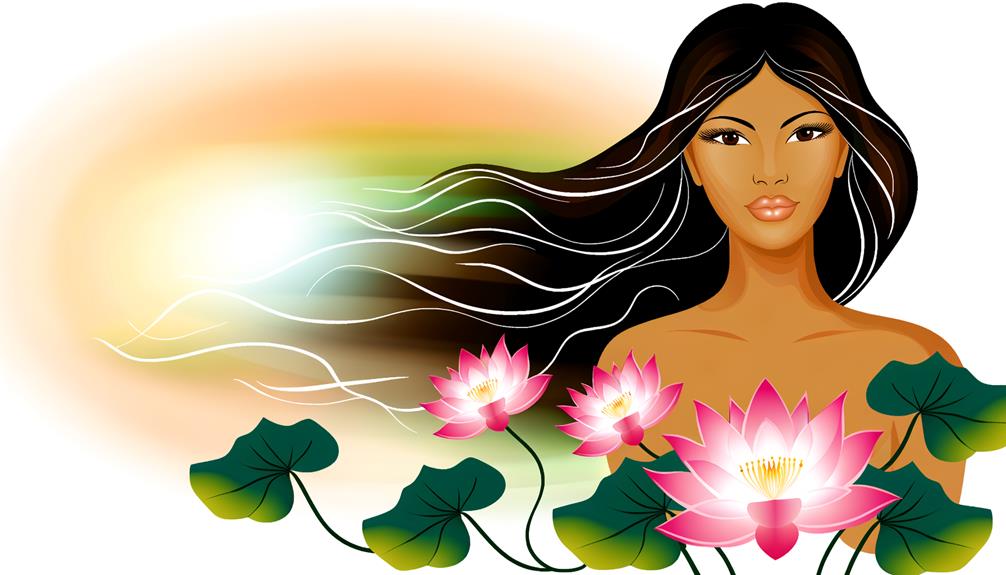Roopa Name Meaning in English
The name Roopa derives from the ancient Sanskrit term 'Rūpa', which signifies form, beauty, and appearance. Historically, it is deeply embedded in Vedic scriptures and Hindu epics, often associated with aesthetic and divine attributes.
Culturally, the name is revered across Indian communities, symbolizing ideals of aesthetic excellence, particularly linked with the goddess Lakshmi. Linguistically, Roopa exhibits variations influenced by regional dialects and is represented in scripts like Devanagari.
The name's popularity fluctuates based on socio-cultural trends but remains cherished for its historical roots and cultural significance. Explore further to uncover the deeper layers of its rich heritage.

Key Takeaways
- Roopa derives from the Sanskrit word 'Rūpa,' meaning form, beauty, or appearance.
- The name is often associated with physical and aesthetic attributes, as well as inner qualities.
- In Hindu mythology, Roopa is linked to goddess Lakshmi, symbolizing prosperity and beauty.
- It reflects ideals of aesthetic excellence and divine grace in Indian culture.
- Roopa retains its essence across linguistic variations like Rupa, Rupali, and Rupsha.
Etymology of Roopa
Tracing its roots to ancient Sanskrit, the name 'Roopa' derives from the word 'Rūpa,' which signifies form, beauty, or appearance.
Historically, 'Rūpa' has been used in various classical texts, including Vedic scriptures and epics, to describe not only physical beauty but also the essence of form and shape.
Linguistically, the term encapsulates a broad spectrum of meanings, extending beyond mere aesthetics to incorporate the inherent nature of an object or person.
The evolution of 'Rūpa' into 'Roopa' indicates a linguistic adaptation that has persisted through centuries, maintaining its core significance.
This etymological journey underscores the name's deep-seated historical and linguistic foundations, reflecting the enduring legacy of Sanskrit in contemporary nomenclature.
Cultural Significance
The historical and linguistic depth of 'Roopa' is matched by its rich cultural significance, as the name continues to be revered and widely used across various Indian communities.
Rooted in the Sanskrit word for 'form' or 'beauty,' 'Roopa' embodies ideals of aesthetic excellence and divine grace. Commonly used in Hindu traditions, the name is often associated with goddess Lakshmi, symbolizing prosperity and beauty.
Additionally, 'Roopa' saturates Indian art, music, and literature, signifying a blend of physical charm and spiritual purity. It is not unusual to find this name gracing the titles of classical compositions and poetic works, further embedding its cultural resonance.
Therefore, 'Roopa' serves as a timeless link between past traditions and contemporary identity.
Historical Context
Rooted in ancient Sanskrit, the name 'Roopa' has traversed centuries, encapsulating the essence of beauty and form in Indian civilization.
Historically, 'Roopa' is derived from the Sanskrit word 'Rūpa', which denotes form, shape, or beauty. This term has been employed in various classical texts and scriptures, reflecting its deep-seated cultural resonance.
Over millennia, 'Roopa' has maintained its significance, often associated with physical and aesthetic attributes in art, literature, and religious contexts.
The enduring nature of the name underscores its linguistic richness and the cultural emphasis on aesthetics within the Indian subcontinent. This historical context reveals the name's profound roots and its sustained relevance across different eras of Indian history.
Linguistic Variations
The name Roopa exhibits notable linguistic variations across different regions, influenced by local dialects and phonetic customs.
In South Asia, particularly in India, variations in pronunciation can be observed, with regional accents affecting its enunciation.
Additionally, the name's representation in various scripts, such as Devanagari, Tamil, and Bengali, leads to distinct spelling differences that reflect the rich tapestry of linguistic diversity.
Regional Pronunciation Differences
How do regional linguistic variations influence the pronunciation of the name 'Roopa' across different cultures and languages?
Historically, the name 'Roopa' has its roots in Sanskrit, where it means 'beauty' or 'form.' However, as this name traversed various linguistic landscapes, its pronunciation adapted to local phonetic rules. In Indian culture, the name ‘Roopa’ is often associated with the concept of inner and outer beauty. In some regions, it may also be interpreted as representing spiritual or divine beauty. Similarly, the meaning of the name Raziya may vary across different cultures and languages, reflecting the diverse interpretations and significance of names in different societal contexts.
In Hindi and other Indo-Aryan languages, 'Roopa' is typically pronounced as ['ruːpə]. Moving to the Dravidian languages in South India, such as Tamil or Kannada, slight shifts occur, with possible elongation or stress variations.
Outside India, in regions like Southeast Asia, local phonemes shape its articulation, sometimes leading to notable deviations. Understanding these differences offers a window into how cultural and linguistic contexts shape name pronunciation over time.
Script and Spelling Variations
Across different linguistic landscapes, the name 'Roopa' exhibits significant script and spelling variations that reflect the historical and cultural evolution of written languages. These variations provide a fascinating glimpse into how this name has been adapted across regions and time periods. The table below illustrates some of these script and spelling differences:
| Language | Script | Spelling Variations |
|---|---|---|
| Hindi | Devanagari | रूपा |
| Bengali | Bengali Script | রূপা |
| Kannada | Kannada Script | ರೂಪಾ |
| English | Latin Alphabet | Roopa, Rupa |
Examining these variations reveals the interplay between phonetic interpretation and orthographic representation, highlighting the adaptability of the name 'Roopa' within diverse linguistic frameworks. This adaptability underscores the rich tapestry of cultural influences that shape naming conventions globally.
Popularity Over Time
Roopa has experienced varying levels of popularity over the decades, reflecting shifts in cultural and linguistic trends. Historically, the name Roopa has its roots in Sanskrit, where it signifies 'form' or 'beauty', lending it a timeless appeal in Indian culture.
Over time, its usage has seen fluctuations influenced by various socio-cultural factors:
- Historical Context: During certain periods, such as the post-colonial era in India, traditional names like Roopa gained prominence as symbols of cultural identity.
- Linguistic Analysis: The phonetic simplicity of Roopa has made it accessible across different Indian languages, enhancing its popularity.
- Origin Tracking: The name's enduring presence in literary and religious texts has continually reinforced its cultural significance.
These factors collectively illustrate Roopa's dynamic presence through history.
Modern Usage
In recent years, the name Roopa has experienced a resurgence in popularity, particularly among millennials who value its rich cultural heritage and linguistic beauty. Originating from Sanskrit, the name carries significant historical and cultural weight, symbolizing beauty and form.
Today, Roopa is celebrated not only for its aesthetic appeal but also for its deep-rooted connection to Indian tradition and modern identity.
Popularity Among Millennials
Curiously, the name Roopa has seen a resurgence in popularity among millennials, often attributed to its rich linguistic heritage and cultural significance. The name, rooted in Sanskrit, translates to 'beauty' or 'form,' appealing to contemporary sensibilities that value both aesthetics and depth.
In historical context, Roopa has been used in various South Asian cultures, often symbolizing grace and elegance. Linguistic analysis reveals its phonetic simplicity and melodic quality, making it an attractive choice for modern parents.
- Historical Usage: Traced back to ancient Indian texts and folklore.
- Linguistic Appeal: Simple yet melodious, easy to pronounce.
- Cultural Resonance: Embodies traditional values while fitting contemporary trends.
These factors collectively enhance its appeal among the millennial generation.
Cultural Significance Today
The contemporary cultural significance of the name Roopa is deeply intertwined with its historical roots and linguistic elegance, making it a timeless choice in modern settings. Derived from the Sanskrit word 'rūpa,' meaning 'form' or 'beauty,' Roopa has maintained its relevance through centuries in South Asian cultures.
Its phonetic fluidity and aesthetic appeal render it adaptable across various languages and regions. In the modern era, the name symbolizes not only physical beauty but also inner grace and character. This duality enhances its popularity among younger generations who value both tradition and contemporary ideals.
Roopa's enduring appeal lies in its ability to convey profound cultural heritage while seamlessly fitting into the lexicon of today's globalized world.
Conclusion
In summation, the name Roopa, deeply rooted in its etymological origins and cultural significance, showcases a rich historical context and diverse linguistic variations.
Its popularity has waxed and waned over time, reflecting broader societal trends. Modern usage demonstrates its enduring appeal.
The name Roopa, like a thread woven through the fabric of history, continues to connect past traditions with contemporary practices, illustrating the timeless nature of linguistic and cultural evolution.






